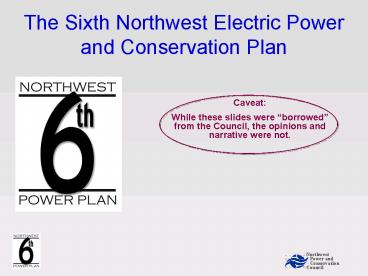The Sixth Northwest Electric Power and Conservation Plan - PowerPoint PPT Presentation
1 / 21
Title:
The Sixth Northwest Electric Power and Conservation Plan
Description:
Conservation Reduces Power System Cost and Risk. Increasing Conservation ... Power and. Conservation. Council. The 'Energy Surplus' ... – PowerPoint PPT presentation
Number of Views:31
Avg rating:3.0/5.0
Title: The Sixth Northwest Electric Power and Conservation Plan
1
The Sixth Northwest Electric Power and
Conservation Plan
Caveat While these slides were borrowed from
the Council, the opinions and narrative were not.
2
Unlike Utility Planning
- Imperfect foresight and use of decision criteria
for capacity additions - Adaptive plans that respond to futures
- Likelihood analysis that captures strategic
uncertainty
slide 2
Planning Principles
3
Comparing System Cost and Risk
System Cost Mean NPV across all futures
Risk Mean NPV of 90th Percentile
12.5
15
17.5
20
22.5
25
27.5
30
32.5
35
10
4
Feasibility Space
Increasing Risk
Increasing Cost
4
Selection of Resource Plans
5
Feasibility Space
Increasing Risk
Increasing Cost
5
Selection of Resource Plans
6
Efficient Frontier
Source Analysis of Optimization Run_L811
090502.xls
Source Analysis of Optimization Run_L811 090510
2101.xls
7
Plan in a Nutshell
- Aggressive conservation
- Renewable generation to meet RPS requirements
- Additional energy, capacity, and flexibility
needs provided by natural gas-fired generation - Cost-effective, small-scale, local renewable and
cogeneration opportunities should be developed
8
Resource Costs Long Term
9
Conservation is Cost-effective Under Many
Different Future Scenarios
10
Conservation Reduces Power System Cost and Risk
Low Conservation
Increasing Conservation
Decreasing Cost and Risk
Plan
High Conservation
11
Wind Development is Driven by Renewable Portfolio
Standards
12
Existing, Committed, and New Wind Generating
Capacity
13
The Energy Surplus
Source Adequacy 6th Plan Base Case 050609_MJS.xls
14
Peak/Off-peak price difference going away
15
CO2 Penalty Distribution
16
Gas-Fired Generation Options
High/Low Conservation is /- 20 of Plan
17
Coal Provides 19 Percent of PNWs Energy
18
Coal plants account for 88 percent of power
system CO2 emissions
19
Carbon EmissionEffects of Scenarios
2005
1990
20
Cost of Carbon Reductions
2005 Emissions
1990 Emissions
21
Typical Residential Electric Bills - with free
CO2 allowances (averaged over 20 years, so
2-4/month higher after coal shutdown or
dam-removal in 2020)































